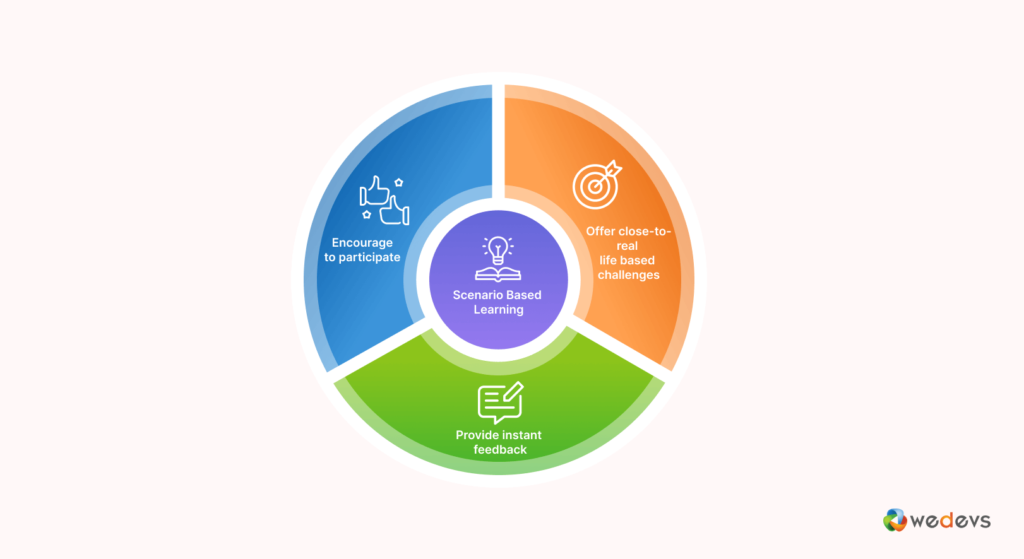
Scenario Based Learning: 5 Tips to Improve Course Design in 2025
The online learning system isn't something new for us. Especially after the pandemic, it has become a necessity. The system has been evolving over time with new features and additions. And the latest addition to this system is “Scenario Based” learning.
Scenario Based Learning is a teaching method that uses real-life situations or hypothetical scenarios to help people understand and learn new concepts or skills.
Scenario based learning market is projected to reach $601.85 billion by 2027, growing at a CAGR of 13.7% from 2020 to 2027.
Allied Market Research
Scenario based learning system helps design your course with different scenarios to make it more engaging for your learners. Trainer all over the world takes this as an opportunity to teach people and earn money from home simultaneously.
If you don't know about scenario based learning and its application yet, don't panic. Because today, in this blog, we are going to discuss it comprehensively for you. Also, we will share some proven tips to create your own scenario based learning system for your learners.
So without any further ado, let's get started!
What is Scenario Based Learning
Scenario based learning is an approach that helps you learn by putting you in realistic situations. It's like learning by doing! Instead of just reading or listening to information, you get to apply your knowledge to solve problems or make decisions.
Imagine you're learning how to be a detective. Instead of only reading about detective work, you would be given a case to solve. You would have to gather clues, analyze evidence, and make decisions based on what you know.

This hands-on experience helps you understand and remember things better. Scenario based learning is used in many fields, like business, healthcare, and customer service. It helps you develop critical thinking skills and practical knowledge that you can use in real-life situations. So, it's a fun and effective way to learn!
Differences Between Problem-Based Learning and Scenario-Based Learning
Apart from scenario learning, you may have also heard about problem based learning systems. Sometimes people use these two terms interchangeably. But is clear differences between problem based learning and scenario based learning systems.
So, before going into any further details of scenario learning, let's check how it is different than problem-based learning:
| Problem Based Learning (PBL) | Scenario Based Learning (SBL) | |
|---|---|---|
| Learning Task | Open-ended, ill-structured problems | Specific situations or scenarios |
| Problem Exploration | In-depth investigation, analysis, and problem-solving | Application of knowledge and skills |
| Structure | Less defined, more open-ended | More defined and structured scenarios |
| Focus | Problem identification, knowledge gaps, and seeking solutions | Application of knowledge and skills |
| Problem Complexity | Complex, real-world problems requiring deep analysis | Situations with defined parameters and expected outcomes |
| Group Dynamics | Collaborative learning in small groups | Collaborative learning in small groups or individual tasks |
| Facilitator's Role | The facilitator guides and supports the learning process | Facilitator provides guidance and feedback |
| Assessment Approach | Focuses on problem-solving, critical thinking, and analysis | Assesses the application of knowledge and decision-making |
Benefits of Scenario Based Learning System

Scenario-based learning has become insanely popular in recent times. Because it comes with a lot of benefits for a learner. Unlike the traditional learning system or some online courses, it has something different to offer for the learners.
Let's find out some of the benefits of a scenario-based learning system:
- Real-World Practice: With scenario-based learning, you get to apply what you learn to real-life situations. It's like practicing for the real thing, which helps you understand how knowledge and skills are used in practical contexts.
- Active Learning: Instead of just listening or reading, scenario-based learning actively engages you. You become an active participant by making decisions, solving problems, and interacting with the scenario. This hands-on approach keeps you involved and boosts your learning experience.
- Critical Thinking: Scenario-based learning encourages you to think critically. You're presented with complex situations that require careful analysis, evaluation of options, and making informed decisions. This helps develop your critical thinking skills, enabling you to tackle challenges effectively.
- Useful Skills: Through scenario-based learning, you develop a range of skills that are valuable beyond the classroom. Decision-making, communication, collaboration, and adaptability are just a few examples. These skills are transferable and can be applied in various situations throughout life.
- Feedback and Reflection: Immediate feedback is an integral part of scenario-based learning. It allows you to understand the consequences of your decisions and actions. This feedback loop helps you reflect on your choices, learn from mistakes, and refine your strategies for future scenarios.
- Relevant Learning: Scenario-based learning connects what you learn to real-life situations. This relevance makes the learning experience more interesting and meaningful. You can see the practical application of knowledge, enhancing your understanding and motivation to learn.
When You Should Use Scenario-Based Learning
Now you know what scenario-based learning is and why it's important for you. But the question is when you should use this method. In this segment, we are going to find out about some such situations.
a) Learner Needs Motivation: Your learner may run out of motivation as the usual learning system can't help him much. In this case, a well-designed scenario plays on their natural curiosity and that human tendency to want to know what happens next and where the story goes. A good scenario also encourages him to finish the course with some challenges to achieve.
b) The Core Content is Complex: Your learner can have a hard time learning complex content like computer languages, legal topics, compliance, and so on. It can also be hard for learners to envisage how this content relates to their everyday life. Opening with a story illustrating the relevance and why it matters is so much more effective than just stating the facts.
c) There Isn't a Single Right Answer: If we ask you what is answer 2+2 is, there is only one answer- that is 4. However, there are some open topics that you can't conclude with a single answer. This is often the case with soft skills like leadership or negotiation. In these cases, you can use scenario based learning system.
d) You Need to Motivate Your Learners to Apply Their Learnings in Real-life: Sales skills, product knowledge, and customer service skills are good examples of this. A traditional exam system can't help you more to understand if your learners will be able to apply their learnings in their job field. Adding scenarios in this exam makes it a more challenging situation, giving you confidence that – if they perform well here – they’ll perform well where it counts.
5 Tips to Create a Successful Scenario Based Learning System

Creating a scenario-based learning system is a challenging job. Because if you can't place it properly, people won't find it helpful.
So, make sure you have followed the below 5 steps procedures to create a solid scenario-based learning system for your learners.
- Identify Your Target Audience
- Determine Your Learning Objectives
- Choose the Scenario Structure
- Write the Story
- Give Learners the Opportunity to Reflect
Now let's discuss each of the above-mentioned points and starts with the first one-
1. Identify Your Target Audience
This point seems familiar to you. It's normal. Because whatever you want to start, first, you need to know who is your target audience. If you failed to figure out whom you are targeting, you never reach their expectation.
Here your target audience is your learner. So, find out who are the learners. Also, you need to know the following facts-
- Are they beginners who just starting out in their careers? Or, do they know a little about the industry? The answer to this question will help you determine their prior knowledge.
- What do your learners expect from the course? Will they take your course to learn a new skill, or do they want to refresh their memories? Those who want a recap would appreciate scenarios that pan out quickly. And those who want to learn new skills from your courses would like to get long scenario-based courses to participate in and make decisions.
- What are their professional goals and aspirations? For instance, it is likely that a senior content writer aspires to be a content strategist someday. So he would expect your technical course to teach him to not only write content but also manage Google search console data and plan content for more traffic.
2. Determine Your Learning Objectives
After finding out your target audience, make a plan for what you want to offer them. And what benefits they will get after completing your course. That means you have to set goals for each of your courses.
This would provide pointers to create scenarios that map to each outcome and also ensure that the learning journey will meet the expected gains.
Don’t forget instructional design basics when creating a learning scenario. Ask: “Where do my learners need to end up at the end of the process?” Understand what the organization needs to accomplish with the entire blend, and identify how the scenario contributes to that goal.
3. Choose the Scenario Structure from Different Models
Now you know your target audience and learning objective. It's time to create a structure for your scenarios. There are mainly three types of structure in the scenario-based learning system.
Every type is suited for teaching a particular type of skill. You have to decide which type will facilitate the most effective way for your target audience. Let's find it out now!
i) Problem-Based Learning Model
These scenarios present learners with an open-ended problem to solve. For example, you can provide your teams with a data set containing the results of a marketing survey and ask the teams to create a marketing plan based on that data.
For instance, imagine you are creating a marketing plan for a new WordPress plugin, and the data set represents your potential market. Then ask them to figure out: What is your plan? How would you enter and create an impact in the market? This is an example of a problem-based scenario.
ii) Predictive-Based Learning Model
These scenarios have learners speculating on the outcome of an event based on their knowledge, supplied details and content, and assumptions.
For example, perhaps you are trying to teach bank tellers how to identify fraud. Provide different scenarios and ask learners to predict what a computer hacker might do next. Keep track of answers on a whiteboard to support a meaningful debrief.
iii) Play-Based Learning Model
These scenarios involve the use of games to work through a challenge. For example, for over five weeks participants work in a consistent team to learn how to create a strategy to sell their product to strategic buyers.
They work in a team to design a plan, create a proposal, make a sales presentation, and try to win the sale! In between the live sessions, they observe real sales presentations and research clients and use that information to support their approach and teach their team members real-live techniques.
4. Write an Engaging Story
Scenario-based learning relies heavily on narrative. If you fail to narrate it properly, people won't trust your course.
Each of your scenarios needs to tell a unique story with characters, setting, plot, challenge, and resolution.
For many designers, crafting the story at the heart of a scenario poses a challenge.
The best scenario stories feel authentic, relatable, and realistic to the learners. You should try to put them in the situations they will face on the job. When selecting timing for the scenario components, connect them to specific outcomes for the entire blend.
5. Give Learners the Opportunity to Reflect
The value of scenarios lies not only in the process of completing the activity but also in the opportunity to reflect on the results and learn from mistakes. Learners need to have the opportunity to debrief on their experience.
What steps did they take in the scenario? What did missteps teach them? The instructional design team needs to ensure that learners meet the defined objective. If learners cannot reach the desired end goal, go back to the drawing board and tweak the scenario as needed.
Top Scenario Based Learning Tools for Beginners

If you want to create scenario based learning courses, you can use a scenario based learning tool. There are several scenario-based learning tools available that can enhance the learning experience. Here are three popular tools widely used for scenario-based learning:
I) Articulate Storyline Tool
Articulate Storyline is a versatile authoring tool that allows you to create interactive scenarios with ease. It offers a user-friendly interface and a wide range of features, such as customizable templates, branching scenarios, multimedia integration, and assessment options. With Storyline, you can develop engaging and interactive scenarios that provide learners with realistic decision-making experiences.
II) Adobe Captivate Tool
Adobe Captivate is another powerful tool for scenario-based learning. It enables you to create interactive simulations, branching scenarios, and immersive learning experiences. Captivate offers features like drag-and-drop interactions, scenario branching, screen recording, multimedia integration, and responsive design capabilities. It provides a flexible platform for designing and delivering scenario-based learning content.
III) BranchTrack Tool
BranchTrack is a specialized tool for creating branching scenarios. It focuses on simplifying the process of building interactive decision-making experiences. With BranchTrack, you can design and customize scenarios, define branching pathways, and add multimedia elements. It also provides analytics to track learner choices and outcomes, allowing you to evaluate the effectiveness of the scenarios.
These three tools offer a range of features and functionalities to create interactive and engaging scenario-based learning experiences. However, it's important to assess your specific requirements and choose the tool that best aligns with your instructional goals and resources.
Scenario Based Learning Examples for Your Inspiration
We are going to give you 5 examples of scenario-based learning systems to take inspiration from. You can check these examples and follow one of them to create your own scenario-based learning.
Example 01: Case Investigation Scenario
If you want to create scenario-based learning for your law firm, you can do that by taking inspiration from the below example.
This is a perfect example of how an investigation should take place. They designed the scenario in such a way that a learner can at first learn the law, then hear the story of the associated people. So that he can understand the scenario and finally come up with his decision.
Example 02: Embedded Scenario
Our second scenario is for an embedded system. If you want to create a learning system where you can teach people from the mechanical sector, you can create a system like the below-mentioned one.
Example 03: Product Knowledge Scenario
If you want to teach people about new technology or product, you can easily create a scenario based learning system like the following one. Here is an example of 3 steps product introduction course for newbies.
Example 04: Soft Skill Learning Scenario
Soft skills like communication, public speaking, presentation, etc are very important nowadays. People look for solid courses where they can learn soft skills and reflect on their learnings.
So, you can take leverage of these people by helping them to learn soft skills with your scenario-based learning system. You can take motivation from the below example to create your own learning system.
Example 05: Gamification Scenario
Gamification doesn’t have to be extremely complicated. You can use elements of “content gamification” such as story, character, and challenge without any fancy tools. You can take this example as your inspiration.

Bonus: How to Create a Scenario-Based Learning System Using WP User Frontend

You can create a membership website to simply manage your scenario-based learning system. A membership website is a site where you share exclusive content and people have to register to your site to access those content. You can charge them monthly or annually to get access to your premium content.
For doing that you need a system where you can upload and publish your courses and restrict them only to registered or premium customers. If you are a WordPress user, then creating such a platform is a comparatively easy task for you. Because a membership plugin like WP User Frontend can help you in this matter.
WP User Frontend is one of the most popular WordPress membership plugins that can turn any WordPress site into a membership site with a few clicks. We have chosen the WP User Frontend plugin here, because, it comes with some advanced features like,
- Frontend profile update
- Post schedule and restriction options
- Live preview system
- Post expiration options
- Registration form builder
As you are intended to create scenario-based learning so you have to design your courses as per the tips that we have discussed earlier in this blog. After successfully making a plan for your learning system, then you should focus on how you can make money out of them.
FAQs on Scenario Based Learning
The benefits of scenario-based learning are-
1. It's engaging- you can easily engage your target audience by creating a close-to real-world-based scenario for them.
2. Learners get what they want- you plan courses as per your target audiences' needs.
3. Critical thinking mentality- it helps to create a critical thinking mentality for every problem in their life and job sector.
4. Ensures better retention rate- if you can perfectly create a scenario-based learning system, people will love to enroll in your courses, as this sector is still not saturated.
There are 5 principles of successful scenario-based learning-
1. Identify Your Target Audience
2. Determine Your Learning Objectives
3. Choose the Scenario Structure
4. Write the Story
5. Give Learner Opportunity to Reflect
This is an example of a scenario- “perhaps you are trying to teach bank tellers how to identify fraud. Provide different scenarios and ask learners to predict what a computer hacker might do next. Keep track of answers on a whiteboard to support a meaningful debrief.”
Mainly there are three types of scenarios-
1. Problem-based scenario
2. Predictive scenario
3. Play-based scenario
Key Takeaways of Scenario Based Learning for You
Scenario-based learning has simplified the learning process for every learner who wants to acquire a skill for their career. You should take this opportunity to teach people if you have expertise in any field. Implement these 5 tips while planning for scenario learning courses:
- Identify your target audience for whom you want to create courses
- Determine what you want to deliver through your courses
- Choose the scenario structure that you want to use for creating your courses
- Write the story for your courses with proper explanations
- Give learners the opportunity to apply their learnings throughout the courses
Also, we have shared top scenario based learning tools so that you can use one of them to get your job done easily and fastly.
As creating and managing a scenario-based learning system has become easy with WP User Frontend, you should kick off your journey today! You can teach people and earn money online simultaneously through it.
If you think this blog can help you in starting your learning system, don't forget to share it with your family and friends. Also, you can let us know your valuable feedback in the comment box below. We would appreciate your thoughts. Thank you.